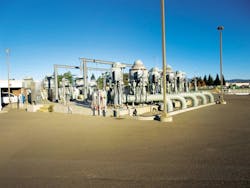Municipal wastewater treatment facilities (WWTFs) are aging, and many have pumps and blowers near the end of their useful lives consuming more power than new equipment would. The increased power cost can be significant, as electricity can be a major component of total facility operation and maintenance costs.
Replacing obsolete pumps and blowers with improved models requires an effort to study the feasibility of upgrades, create designs and specifications, allocate capital budgets, and typically publicly bid the project. As a result, existing pumps and blowers sometimes stay in place until they fail. When this happens, time constraints often mean the failed component will be replaced with an identical unit. An opportunity may be missed to replace the pump or blower with a newer, more energy-efficient design.
On the other side of the meter, electric utilities have found it is less costly to meet increasing power demands by helping their customers use electricity more efficiently, rather than build more power plants and distribution systems. In California, numerous utility-sponsored energy efficiency programs targeted to specific industries help customers use less electricity.
In Northern California, one such program is the California Wastewater Process Optimization Program (CalPOP), managed by Quantum Energy Services and Technologies (QuEST) of Oakland, Calif. Summit Eng. Inc. is an engineering partner with QuEST for the program. CalPOP has examined 65 facilities since its inception in 2001, providing cash incentives, loans and engineering support to break down the barriers WWTFs face in upgrading to more efficient equipment. About two-thirds of the WWTFs that partnered with CalPOP have completed at least one recommended energy efficiency project.
Savings in San Leandro
The city of San Leandro, Calif., is located on the east side of San Francisco Bay. Its WWTF, H2OWorks, serves approximately 50,000 residents, numerous businesses, and 22 industrial dischargers.
San Leandro’s design dry weather flow is 7.6 million gal per day (mgd). It has a secondary treatment train with a fixed-film bioreactor (trickling filter), and aeration basins with fine-bubble diffusers. Aeration was supplied by three aging 150-hp multistage fixed-speed blowers. A CalPOP energy audit identified these blowers as energy wasters due to poor turndown characteristics. Air demand varies widely based on incoming wastewater load. When air demand is low, the multistage blowers have poor energy efficiency.
In the past decade, variable-speed single-stage turbo blowers have been introduced to WWTFs. These can reduce air output more efficiently than multistage blowers and save energy. The CalPOP audit recommended replacing one of the multistage blowers with a turbo blower.
The audit qualified San Leandro for a zero-interest capital cost loan from the power utility, to be paid back from energy cost savings; San Leandro did not have to use its own capital funds. The 150-hp turbo blower was supplied by ABS-HST, based in Finland. The turbo blower has been able to supply all the air needed 99% of the time. Previously, two multistage blowers often were needed for peak air demands. The new blower improved dissolved oxygen control and limited the wide swings it experienced when aeration was be switched from one to two multistage blowers. The CalPOP post-install verification measurements predicted the annual aeration power cost will be cut in half, saving $59,700 per year, with a 3.6-year simple payback. San Leandro also received a $48,519 cash incentive from the electric utility based on the verified energy savings.
Livermore Amador Valley Lessons
The Livermore Amador Valley Water Management Agency (LAVWMA) collects treated wastewater from four inland cities east of San Francisco Bay—Dublin, San Ramon, Pleasanton and Livermore. LAVWMA owns and operates the Export Pump Station and Pipeline to pump the treated wastewater across a 415-ft elevation rise and approximately 16 miles for discharge into San Francisco Bay.
Ten large pumps (six 500 hp, four 600 hp) provide the 41-mgd peak capacity. The 500-hp pumps were placed in service in 1987, when factory tests indicated 77% overall efficiency. In 2010, when CalPOP performed a study, their efficiency had declined to 65%.
Most of the discharge check valves on the pumps had leaks, meaning water that had been pumped was flowing back into the pump suction basin and would have to be pumped a second time. This water amounted to 82 million gal per year, or approximately 2% of the station’s total annual pumped volume.
The CalPOP study recommended replacing the four least-efficient 500-hp pumps and all eight leaking check valves. One of the four targeted pumps was close to failure and was replaced, and all eight targeted check valves were replaced. The verified annual energy savings were $23,000 per year, on a $140,000 investment, resulting in a six-year simple payback. In addition, CalPOP paid LAVWMA a $17,800 cash incentive for these improvements. The remaining three targeted pumps are slated for replacement in summer 2017. They are expected to provide at least an additional $30,000 per year in energy savings.
The CalPOP program was able to provide engineering support, cash incentives and zero-interest loans when needed. The sponsoring electric utility—and its ratepayers—benefitted when the electricity wasted by the aging equipment was freed up, reducing the need for new power plants and distribution systems.

